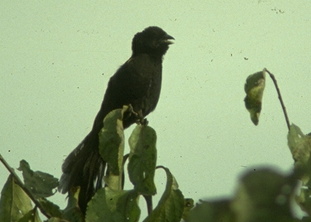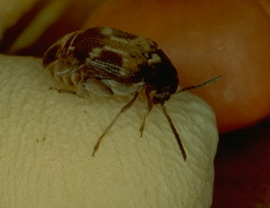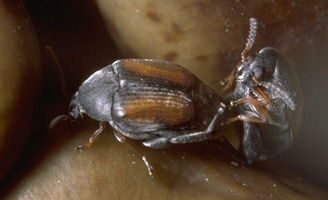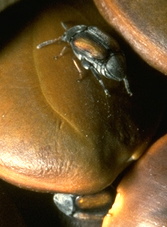Udo SavalliResearch Interests |
Contact Information:Integrated Natural SciencesArizona State University West Campus Glendale, AZ 85306 Phone: 602-543-3750
|

My research interests concern the function and evolution of social behavior--especially as it pertains to reproductive strategies. This includes mating systems, social systems, parental investment, sexual selection, sexual dimorphism, communication, and coloration. I have worked primarily with birds and insects.

My most recent research was carried out in the laboratory of Dr. Charles Fox, first at Fordham University's Louis Calder Center and later at the University of Kentucky. I worked with two species of seed beetles (Family Bruchidae), the cowpea weavil, Callosobruchus maculatus, and a desert seed beetle, Stator limbatus (left picture). I investigated the roles of male-male competition, sperm competition and female choice in the evolution of male body size, ejaculate size and sexual dimorphism and female reproductive strategies such as mate choice, multiple mating, and egg size decisions (below).
and female reproductive strategies such as mate choice, multiple mating, and egg size decisions (below).
My dissertation research for my PhD at the University of California at Berkeley investigated sexual selection in yellow-shouldered widowbirds, Euplectes macrourus (right picture). My research was carried out mostly in the field at the Kakamega National Reserve, in western Kenya. I investigated the roles of male-male competition and female choice in evolution of the long tails of males (below).

Seed beetle research

My research with seed beetles involved various aspects of life history evolution, behavioral ecology, and sexual selection. In most insects, females are larger than males despite frequent evidence for sexual selection favoring large male body size. Large female size is usually attributed to fecundity selection (larger females can lay more eggs over their lifetime). I investigated sexual selection and fecundity selection on male body size in two related species of seed beetle: in Callosobruchus maculatus (left) males are smaller than females, but in Stator limbatus (below-right) males are larger. My laboratory studies so far indicate that sexual selection favors large males in both species through male-male competition and through sperm competition (females mating with large males are less likely to remate); if anything, the large male advantage was more pronounced for C. maculatus , in which males are smaller than females. In neither species do females exhibit a clear preference for larger males, although once mated, females are less likely to remate if they first mated with a large male. These species differ in another respect: in S. limbatus , variation in male size (which affects ejaculate size) contributes substantially to variation in female lifetime fecundity. This suggests that fecundity selection is also acting on males and may in part account for the relatively large size of males.
In neither species do females exhibit a clear preference for larger males, although once mated, females are less likely to remate if they first mated with a large male. These species differ in another respect: in S. limbatus , variation in male size (which affects ejaculate size) contributes substantially to variation in female lifetime fecundity. This suggests that fecundity selection is also acting on males and may in part account for the relatively large size of males.
My finding that male size influences female reproductive success suggests that ejaculate size may be of considerable importance to both males and females. Therefore, I investigated the importance of ejaculate size to female reproductive success and the factors that influence male ejaculate size in these species (most work is carried out with C. maculatus since this species is more tractable for these experiments). For example, I investigated  the effect mating with a virgin versus a previously mated male (that has a smaller ejaculate) has on a female's lifetime fecundity, as well as her tendency to remate. Females mating to previously mated males have lower lifetime fecundity than females mating to virgins. A male's mated status also influences a female's tendency to remate: females mated to non-virgins remate more rapidly than females mated to virgins. This is at least in part due to the nutritional benefits provided by the male (rather than just a need for additional sperm) since females provided with additional nutrients (food) were less likely to remate. Given that male contributions are limiting (ejaculate size drops precipitously from one mating to the next), males might be expected to be selective in who they fertilize and how much they contribute. My studies so far have detected no evidence of male mate choice, however.
the effect mating with a virgin versus a previously mated male (that has a smaller ejaculate) has on a female's lifetime fecundity, as well as her tendency to remate. Females mating to previously mated males have lower lifetime fecundity than females mating to virgins. A male's mated status also influences a female's tendency to remate: females mated to non-virgins remate more rapidly than females mated to virgins. This is at least in part due to the nutritional benefits provided by the male (rather than just a need for additional sperm) since females provided with additional nutrients (food) were less likely to remate. Given that male contributions are limiting (ejaculate size drops precipitously from one mating to the next), males might be expected to be selective in who they fertilize and how much they contribute. My studies so far have detected no evidence of male mate choice, however.
I also investigated the various factors that affect male ejaculate size. For example, I examined if there was genetic variation in ejaculate size (and hence the potential for it to evolve). The results from a half-sib experiment in one population suggest that at least some of the loci affecting this trait are located on the X-chromosome (although we can not completely exclude the possibility of a maternal effect). On the other hand, comparisons among populations demonstrate that among-population variation appears to be due to variation at autosomal loci. In addition to examining genetic variation in ejaculate size, I also investigated various environemnetal factors that may affect male nutritive contributions to females. For example, larval rearing density affects ejaculate size, but only insomuch as rearing density affects adult body size: males contribute a relatively fixed proportion of their body mass in their ejaculate. I looked for but was unable to obtain any evidence that males are able to adjust ejaculate size in different social circumstances (such as population sex ratio).

Widowbird research

Male Yellow-shouldered Widowbird |

Female Yellow-shouldered Widowbird |
My dissertation research involved field experimentation with yellow-shouldered widowbirds, Euplectes macrourus , in Kenya. This species is closely related to the famous long-tailed widowbird studied by Malte Andersson, but breeding males  have a much shorter tail (though still longer than in females or non-breeding males). My goal was to more rigorously test alternatives to female choice for the evolution of long tails, as well as to identify reasons for the considerable geographic and interspecific variation in male tail length within the widowbirds (tail length in the genus Euplectes varies from 3 to 50 cm). Using experimental manipulations of tail length, I demonstrated that tail length functions primarily in male-male competition for territories (males with shortened tails lost their territories more frequently than did control or tail-lengthened males). On the other hand, I found no evidence for female choice of long-tailed males, using either natural variation or experimentally manipulated tails. Instead, female preferences were for males that built numerous nest frames (see picture to right), and more weakly, for certain territory attributes. Thus, my studies ran counter to Andersson's findings with long-tailed widowbirds which emphasised the importance of female choice for long tails; it is possible that this difference accounts for the differences in tail length between these species. My work clearly showed that male-male competition--and not just female choice--can lead to the evolution of conspicuous, sexually dimorphic ornaments.
have a much shorter tail (though still longer than in females or non-breeding males). My goal was to more rigorously test alternatives to female choice for the evolution of long tails, as well as to identify reasons for the considerable geographic and interspecific variation in male tail length within the widowbirds (tail length in the genus Euplectes varies from 3 to 50 cm). Using experimental manipulations of tail length, I demonstrated that tail length functions primarily in male-male competition for territories (males with shortened tails lost their territories more frequently than did control or tail-lengthened males). On the other hand, I found no evidence for female choice of long-tailed males, using either natural variation or experimentally manipulated tails. Instead, female preferences were for males that built numerous nest frames (see picture to right), and more weakly, for certain territory attributes. Thus, my studies ran counter to Andersson's findings with long-tailed widowbirds which emphasised the importance of female choice for long tails; it is possible that this difference accounts for the differences in tail length between these species. My work clearly showed that male-male competition--and not just female choice--can lead to the evolution of conspicuous, sexually dimorphic ornaments.
In addition to examining the role of sexual selection, I also considered non-sexual selection alternatives to the evolution of long tails, something that is rarely ever done in the sexual selection literature. I specifically examined the species recognition, aposematism/unprofitable prey, and genetic drift hypotheses using both field data and a comparative approach. Manipulation of tail length in yellow-shouldered widowbirds did not influence male pairing success and did not affect interactions with congeners that shared their territories. Furthermore, a comparative study of tail lengths based on museum specimens did not show any clear patterns of tail length divergence in areas of sympatry, as predicted by the species-recognition hypothesis. Both of these results suggest that species recognition is not a function of varied tail lengths in widowbirds. The aposematism hypothesis can also be rejected since it is inconsistent with the considerable variation in tail length (such signals should converge rather than diverge) and lack of clear patterns of character convergence (again based on museum specimens), as well as a lack of a relationship between tail length and palatability (the latter obtained from the literature). I was unable to reject genetic drift as a possible explanation for interpopulation variation in tail length (despite the considerable variation and evidence of directional selection on tail length in three species); this may be due in part to inaccuracies in estimating several of the parameters of the genetic model used. Thus, my work differs from most research on sexual selection in that I considered and tested various alternatives that could also account for long male tails.
Despite evidence that sexual selection favors long tails in three species of widowbirds, it is still not clear why there is so much geographic and interspecific variation in tail length. One possibility that I already mentioned is that it is due to different modes of sexual selection: in the species in which male-male competition is more important, tails are relatively short (100 cm), while in species in which female choice is more important, tails are longer (>250 cm). Currently there is neither the empirical nor theoretical basis to indicate whether female choice should lead to more extravagant traits than male-male competition, and this is an area worthy of further investigation. Another possibility is that the cost of having long tails varies between species. One possible cost is that long tails make flight difficult in rain (the water itself and the impact of the drops would weigh down the birds; long-tailed widowbirds are incapable of flying in the rain). This possibility is supported by my comparative study which showed that species living in drier climates tend to have longer tails than those in wetter climates (the trends persist even when phylogenetic effects are partly controlled for).

Additional Information:
- A complete list of my publications
- Selected abstracts from my publications
- My study site, the Kakamega National Reserve, Kenya
- Checklist of birds of the Kakamega Forest

Some Links to Pages of Related Interest
- Birdnet the master site for all of the North American Ornithological Societies, with many links.
- Animal Behavior Society
- Center for Ecology and Evolution and Behavior at U.K.
- Nebraska Behavioral Biology Group information about their own program plus links to many other relevant sites
- Animal Behavior at Indiana University
- Evolution Links
- The Tree of Life
- Charles Fox--Bruchid Evolutionary Biology
- The Bruchid page at Royal Holloway
- Timothy Mousseau--Evolutionary Biology of Crickets & Beetles
- Paul Watson--Animal Behavior
- Carl Bergstrom -- Signalling Theory and Animal Behavior
- Honest Signalling Theory: An Online Tutorial
- Pheasant Spurs Sexual Selection
- David Westneat--Reproductive Tactics in Birds
- Rebecca Irwin--Plumage Evolution in Meadowlarks and Blackbirds
 This page last modified on January 6 2007, by Udo M.
Savalli ()
This page last modified on January 6 2007, by Udo M.
Savalli ()